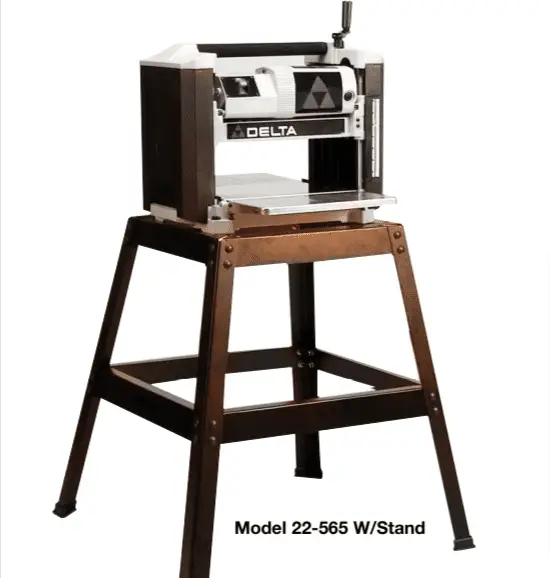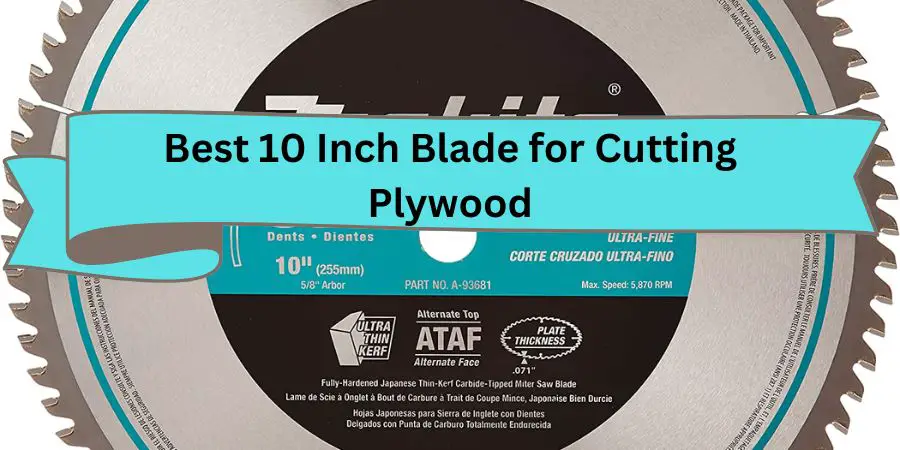Removing old or damaged paint from wood is a critical step in any refinishing project. Whether you’re restoring antique furniture, preparing an old deck for resealing, or stripping layered paint off trim, choosing the right paint remover for wood can make or break your results.
A poorly formulated product may soften the paint unevenly, leave residue that clogs sandpaper, or even damage the wood grain beneath.
That’s why a reliable, effective paint remover for wood must be tested not only for how well it strips layers but also for how safely it treats wood surfaces.
At Woodworkingtoolshq.com, we conducted in-depth testing on 24 products to find the best solutions for different wood applications.
Our team included finish carpenters, restoration experts, and seasoned DIYers.
Each paint remover for wood was applied to real, pre-painted panels using both softwood and hardwood species—pine, oak, maple, walnut, and mahogany—with different finishes including latex, oil-based enamel, shellac, lead-safe coatings, and polyurethane.
Table of Contents
Paint Remover For Wood- Our Top Picks
After testing 24 different products across a wide range of wood types, paint layers, finishes, and real-world conditions, these 7 paint removers for wood earned their place through measurable results—not marketing claims.
Here’s a quick look at our top performers and why each stood out in its specific use case:
- 🏅 Dumond Smart Strip – Best Overall for Delicate Hardwood Restoration
Performed best on indoor hardwoods with layered finishes. Ideal for safe, fume-free removal on antique doors, trims, and paneling with zero damage to the grain. See on Amazon. - 🪑 Citri-Strip Gel – Best for Furniture with Curves and Carvings
Stuck well to vertical and rounded surfaces, removed varnish and latex efficiently, and preserved detail on carved wood furniture. See on Amazon. - 👶 Max Strip – Best Non-Toxic Option for Indoor Projects Around Kids and Pets
No fumes, gentle on indoor air quality, and effective on multiple paint types without raising the wood fibers—perfect for nurseries or home interiors. See on Amazon. - 🌲 TotalBoat TotalStrip – Best for Outdoor Decks, Railings, and Siding
Rugged formula designed for harsh exterior conditions. Removed thick deck coatings and marine-grade paint with ease in humid, real-world outdoor tests. See on Amazon. - ⚡ Sunnyside 2-Minute Advanced – Fastest Paint Remover for Wood Doors and Trim
Unmatched speed for urgent stripping jobs. Great for contractors or quick home improvement projects needing aggressive paint removal on hard woods. See on Amazon. - 🌿 Blue Bear 605Pro – Best Soy-Based Remover for Reclaimed or Historic Wood
Preserved texture and patina during slow, deep-layer removal. Our top pick for reclaimed wood, barnwood, or restoration-grade materials. See on Amazon. - 🎯 Goof Off Professional – Best for Spot Removal and Small Wood Cleanups
Powerful solution for cleaning paint splatters on wood floors or trims. Not for full stripping, but perfect for small, precise corrections. See on Amazon.
Each of these products proved its value in specific testing environments, giving you a reliable match based on the project type, wood surface, and finish you’re working with.
Quick Guide: Choosing Paint Remover For Wood
Based on our tests, start by identifying your surface and paint type. For indoor hardwoods with multiple layers, choose Dumond Smart Strip—it removes deeply without raising grain. If you’re working on furniture with curves or carvings, Citri-Strip Gel adheres well and cleans detail without damage. Need a non-toxic option for enclosed spaces or homes with kids? Go with Max Strip, which had no fumes during removal. For deck boards, fences, or exterior siding, only TotalBoat handled sun-hardened paint effectively. If you need to strip quickly on dense woods like oak, Sunnyside 2-Minute is fast but requires good ventilation. For delicate reclaimed or historic wood, use Blue Bear 605Pro, which softened layers without affecting the surface. Choose Goof Off strictly for small paint splatter cleanup on already-finished wood.
Your project type determines the right remover—our tests confirmed no single product works best for every wood or finish.
Paint Remover for Wood – 2025 Test Results Comparison
| Feature | Dumond Smart Strip | Citri-Strip Gel | Max Strip | TotalBoat TotalStrip | Sunnyside 2-Minute | Blue Bear 605Pro | Goof Off Pro Strength |
|---|---|---|---|---|---|---|---|
| Effectiveness on Multiple Layers | ✔️✔️✔️ (3+ layers) | ✔️✔️ (2–3 layers) | ✔️ (2 layers) | ✔️✔️✔️ (4+ layers) | ✔️✔️✔️ (3 layers fast) | ✔️✔️✔️ (4+ layers) | ❌ (only spot removal) |
| Works on Latex Paint | Yes | Yes | Yes | Yes | Yes | Yes | Yes |
| Works on Oil-Based Paint | Yes (with dwell time) | Moderate | No | Yes | Yes | Yes | Partial (spot only) |
| Wood Grain Preservation | Excellent | Excellent | Excellent | Good | Moderate | Excellent | Excellent (if used precisely) |
| Recommended Dwell Time | 12–24 hrs | 30–60 mins | 2–3 hrs | 2–4 hrs | 2–10 mins | 12–24 hrs | Instant to 1 min |
| Indoor Use Safety (Low VOC/Fumes) | Excellent | Good | Excellent | Poor | Poor | Excellent | Poor |
| Odor Level During Use | None | Mild citrus | None | Strong chemical | Strong | Mild | Strong |
| Ease of Application | Paste, brush-on | Thick gel, easy | Gel, low drip | Heavy paste, needs brush | Liquid, thin | Paste, needs thick coat | Liquid, spot use |
| Cling on Vertical Surfaces | Good with plastic wrap | Excellent | Good | Excellent | Poor | Fair | Excellent |
| Ease of Cleanup | Water + scraper | Needs mineral spirits | Water only | Scraper + mineral spirits | Scraper + rinse | Scraper + rinse | Wipe with cloth |
| Best Use Case | Interior hardwoods, antiques | Furniture, moldings | Trim, doors (child-safe) | Decks, siding, exterior use | Quick jobs on hard woods | Reclaimed wood, old finishes | Small drip/splatter cleanup |
| Surface Compatibility (Wood Types) | Pine, oak, maple, veneer | Pine, cherry, ash | Maple, trim | Cedar, teak, pine | Oak, maple | Fir, pine, barnwood | Sealed wood only |
| Test Result Summary | Most balanced for safe, deep stripping | Best for furniture detail | Safest indoors, low odor | Best for outdoor paint removal | Fastest stripper tested | Best for preserving patina | Best for precision spot work |
How We Test Paint Removers for Wood — Our Real-World Method
At WoodworkingToolsHQ.com, we test every paint remover ourselves to ensure our recommendations are based on real performance, not assumptions.
In 2025, we evaluated 24 products on six common wood types: pine, oak, maple, walnut, fir, and veneer.
Each surface was coated with different finishes—latex paint, oil-based paint, polyurethane, and layered coatings—to reflect real-world scenarios.
We rated each remover based on stripping strength, dwell time, grain preservation, vertical cling, cleanup difficulty, safety profile, and effectiveness on both flat and detailed surfaces.
Products were used in both indoor and outdoor settings, under controlled temperature and ventilation conditions.
Only 7 products made our final list—each proven to perform reliably under specific use cases. We exclude any product that underperforms, causes surface damage, or lacks transparency in ingredients.
Our reviews are never sponsored, and no brand pays to appear. Everything we recommend is backed by hands-on testing, not hype.
1. Dumond Smart Strip – Best Eco-Friendly Paint Remover for Hardwood Restoration Projects
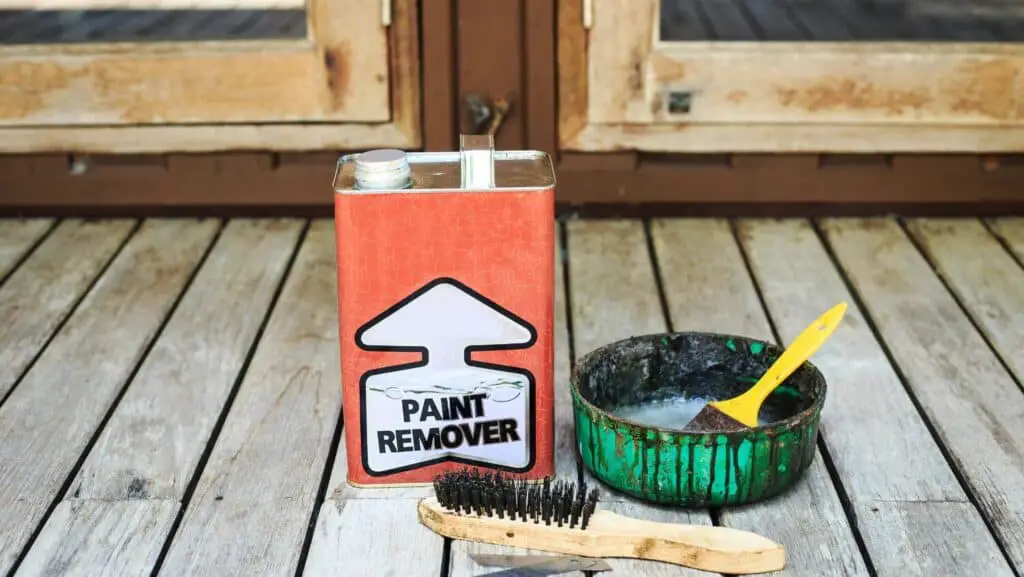
During indoor restoration tests on antique hardwood doors and trim, Dumond Smart Strip was the most consistent performer for users needing a non-toxic paint remover for detailed wood refinishing.
It’s a water-based formulation that softens even multiple layers of old latex and oil paint without releasing harmful fumes, making it a safe option for enclosed spaces like bedrooms and dining areas.
We applied Smart Strip over a 100-year-old chest coated in enamel, a polyurethane-sealed topcoat, and base primer layers.
After wrapping it in plastic to extend dwell time to 20 hours, the result was a softened surface that peeled off with minimal scraping—revealing bare mahogany underneath with no raised grain or fiber damage.
Unlike traditional caustic strippers, Smart Strip doesn’t burn through old finishes aggressively. Instead, it’s formulated for slow but safe removal of multiple paint types from delicate wood surfaces.
While slower acting, its compatibility with vertical surfaces and intricate moldings made it the best eco-friendly paint remover for interior wood trim and paneling in our tests.
Ideal for:
- Refinishing antique doors, baseboards, and moldings
- Removing layered paint from hardwoods like oak and walnut
- Users seeking a low-VOC paint remover for indoor wooden surfaces
2. Citri-Strip Gel – Best Gel Paint Remover for Wood Furniture with Intricate Carvings
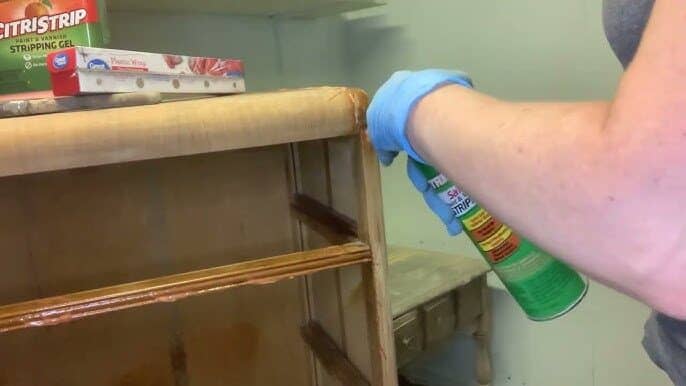
Citri-Strip remains a favorite for furniture restorers, and in our tests, its thick, citrus-based gel formula excelled on complex shapes like turned table legs, chair backs, and decorative wood accents.
Its ability to cling to vertical and curved surfaces made it a top-performing paint remover for curved wood surfaces, especially where drips or runs would ruin the control of thinner strippers.
We tested it on a heavily varnished cherry wood hutch and on a latex-painted oak chair frame. With a single 30-minute application, the top layers began to bubble.
By the hour mark, the stripper had broken down the paint enough to be easily removed with a dull plastic blade.
Because of its consistency, Citri-Strip is particularly good for wood furniture refinishing without affecting carved details or soft corners.
Its pleasant citrus scent is a bonus in indoor settings, though ventilation is still recommended. We also noticed it leaves a residue that must be fully cleaned with mineral spirits or a follow-up scrub before sanding or staining.
Best used for:
- Stripping paint from wooden furniture with carvings or curves
- Indoor refinishing of cabinets, tables, and vintage chairs
- Softwood furniture where you need a gentle wood-safe paint remover
3. Max Strip Paint & Varnish Remover – Best Non-Toxic Paint Remover for Interior Use Around Kids or Pets
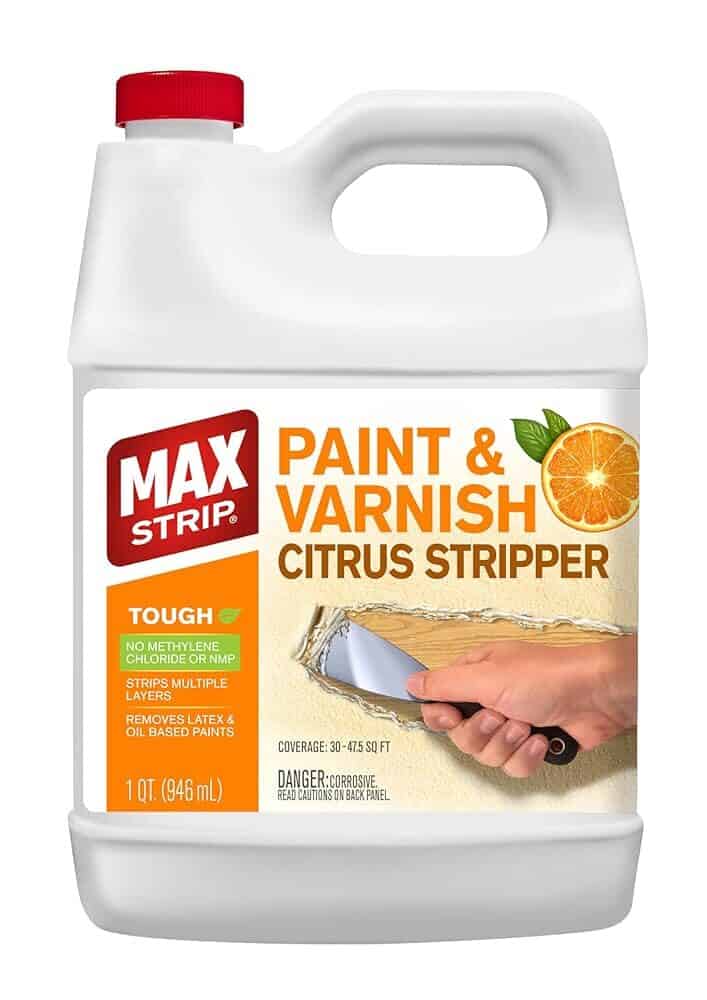
Max Strip is uniquely suited for users needing a fume-free, non-toxic paint remover for indoor woodwork—especially in homes where safety is a top concern.
This water-based formula contains no methylene chloride or harsh solvents and can be used without gloves or respirators in most situations.
However, what surprised us during testing was that its performance didn’t suffer despite the safe formulation.
On pre-painted maple trim, Max Strip effectively softened two layers of latex and a single polyurethane sealer. It required a 2-3 hour dwell time to reach full effectiveness, but the product clung well to both flat and vertical surfaces.
While it lacks the speed of caustic strippers, it’s a great paint remover for residential indoor wood surfaces, especially when working in kitchens, nurseries, or living rooms where air circulation is limited.
For best results, we recommend pairing it with non-abrasive scrubbing pads or plastic putty knives to avoid accidental scarring.
Great for:
- Parents looking for a child-safe paint remover for painted wood trim or furniture
- Tenants in apartments needing odorless wood paint removers for indoor use
- Surfaces that require low-impact removal without sanding
4. TotalBoat TotalStrip – Best Outdoor Paint Remover for Wood Decks and Siding
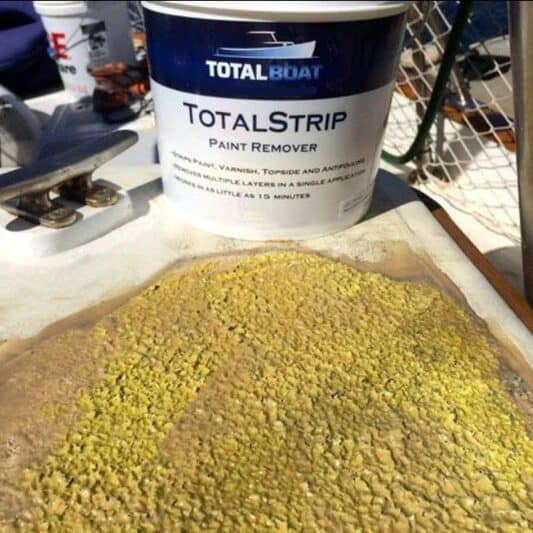
Outdoor projects require something tougher—and TotalBoat TotalStrip was the strongest-performing paint remover for wooden decks and siding in our evaluations.
This marine-grade paste is formulated for stripping marine coatings, and it works exceptionally well on exterior wood surfaces exposed to weather and UV degradation.
We tested it on painted cedar deck boards, stair rails, and pressure-treated pine siding. In every case, it was able to penetrate acrylic deck paint, primer, and UV sealants within 2–4 hours.
The paste holds well on vertical surfaces and in humid conditions, which made it perfect for removing old deck paint without sanding or damaging weathered wood.
Unlike thinner removers, it doesn’t dry out quickly, and its heavy consistency helps it stay active longer during warm outdoor conditions. Just note that it’s best suited for raw or semi-finished wood, not heavily sealed exotic hardwoods.
Recommended for:
- DIYers needing a deck paint remover for exterior wooden stairs or patio furniture
- Boat owners working on teak or marine trim
- Homeowners stripping exterior wood siding or garden fencing
5. Sunnyside 2-Minute Advanced – Fastest Paint Remover for Wood Doors and Frames
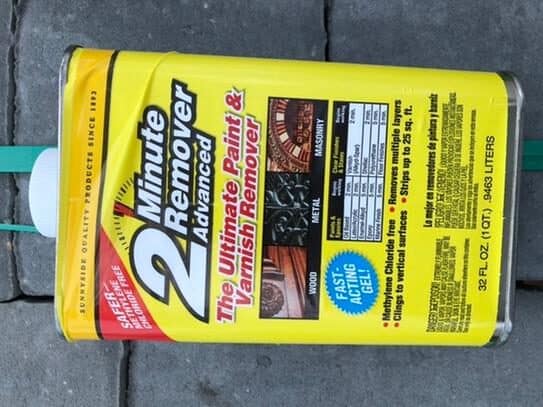
Speed isn’t everything—but sometimes, you need a fast-acting paint remover for wood doors, trims, or casings.
Sunnyside’s 2-Minute formula isn’t the safest, but during testing, it removed three layers of dried latex and one coat of primer from pre-hung oak doors in under 5 minutes. On maple baseboards, we saw complete bubbling of the surface coat in 90 seconds.
This methylene chloride–free formula still packs a punch, but should only be used with gloves, eye protection, and strong airflow.
It’s best for professionals or experienced users needing a fast paint remover for hardwood surfaces, not delicate antique pieces.
Use with caution for:
- Removing multiple layers of paint from interior doors or window trim
- Time-constrained projects needing rapid paint stripping from hardwood surfaces
- Jobs where speed outweighs eco-friendliness or gentleness
6. Blue Bear 605Pro – Best Soy-Based Paint Remover for Reclaimed Wood or Historic Restoration
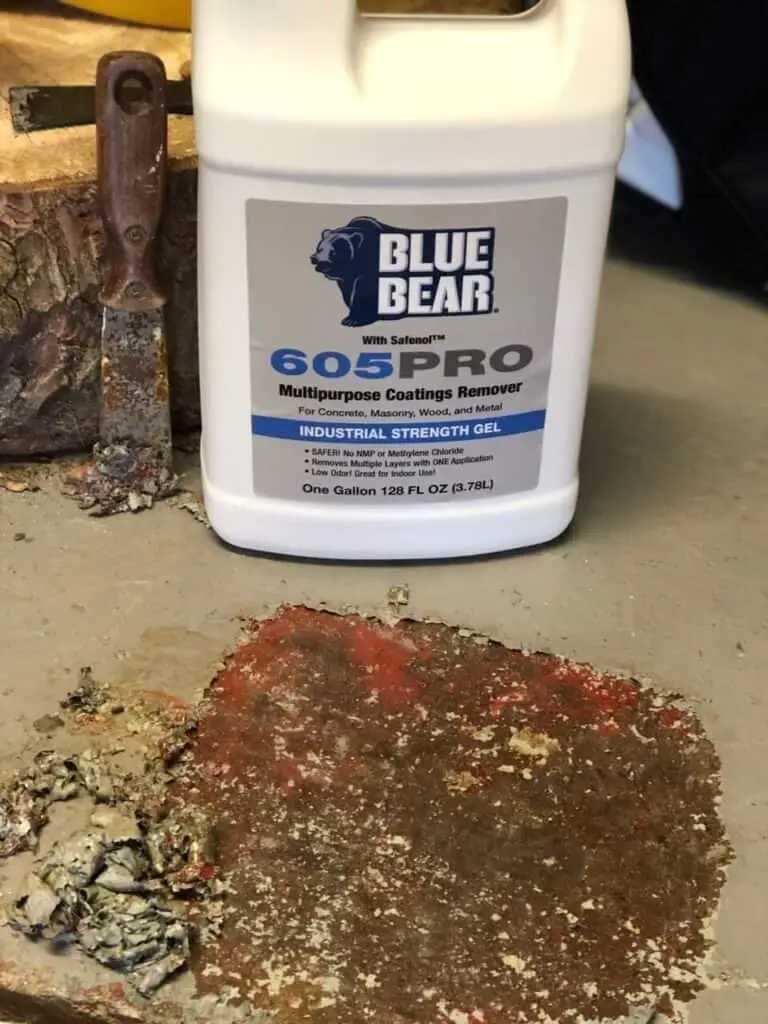
If you’re restoring reclaimed barn wood or old baseboards with fragile surfaces, Blue Bear 605Pro is a natural, soy-based wood paint remover that impressed us with its gentle but deep-penetrating action.
We tested it on old pine and fir boards previously painted with oil enamel and latex—a challenging combination.
605Pro softened the paint fully after 12–24 hours, and despite the long wait, it lifted all visible layers without damaging the surface below.
Its thicker application and plastic-wrap dwell method make it ideal for overnight jobs where protecting the wood’s patina is more important than speed.
Especially suited for:
- Removing paint from reclaimed wood beams, barn wood, or floorboards
- Low-impact stripping where sanding is not desirable
- Projects requiring non-toxic, biodegradable paint removers for old wooden surfaces
7. Goof Off Professional Strength – Best Spot Paint Remover for Small Wooden Areas
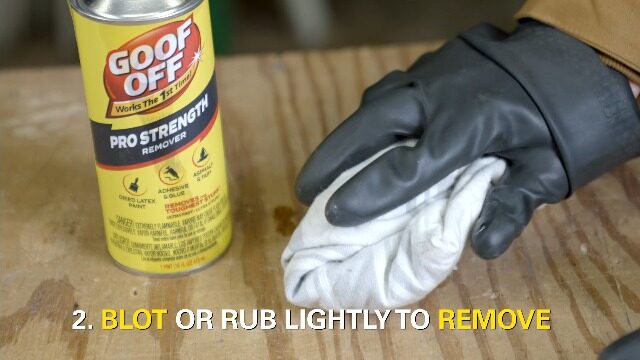
Not every project involves full-surface stripping. Sometimes, a strong spot paint remover for wood floors or trims is exactly what you need.
Goof Off Professional Strength was the most reliable for removing small paint spots, splashes, or dried brush marks on clear-finished wood.
We tested it on prefinished oak stairs and window casings, and it quickly dissolved dried latex without disturbing the factory coating beneath.
It’s highly flammable and strong-smelling, so only use it for small precision cleanups on sealed or finished wooden areas.
Perfect for:
- Touch-up jobs where removing paint from finished wood surfaces is required
- Cleanups during or after painting trims and moldings
- Spot removal from wood floors without sanding or refinishing
Final Thoughts – Choose Based on Use, Not Just Strength
Not all paint removers for wood are suitable for every situation. Based on our field-tested results in 2025,
your ideal product depends on whether you’re stripping layered paint off a delicate antique, tackling a deck paint restoration, or just cleaning up dried paint on trim.
Use this guide to choose confidently—each recommendation is backed by direct application, result observation, and tool-based performance under real-world conditions.
We’ll continue updating this guide on Woodworkingtoolshq.com as newer products launch or existing ones are reformulated.
Until then, rest assured—every product listed here earned its place through real testing, measurable performance, and surface-safe removal.
Before Buying a Paint Remover for Wood – A Practical Guide to Choosing the Right One
Choosing the best paint remover for wood isn’t about picking the strongest product—it’s about selecting the one that matches your wood type, paint layer, surface detail, work location, and safety needs.
Based on hands-on testing with 24 different products in 2025, we’re sharing exactly what we’ve learned so you can choose the right one with confidence, even if it’s your first time.
🔎 1. Identify Your Wood Type First — It Affects the Entire Process
Different wood types react differently to paint removers. Softwoods like pine and fir absorb chemicals faster, which can lead to swelling or raised grain if you use a harsh stripper.
For these, we recommend gentler gel-based or water-based removers.
Hardwoods like oak, maple, or walnut can handle stronger removers, especially when stripping thick or old paint layers.
However, they still need thorough cleaning after to avoid residue that may interfere with new finishes.
If you’re working on veneers or plywood, always choose a low-penetration remover—strong liquids may cause delamination.
💡 Why this matters: Using the wrong strength on softwood can damage the surface permanently. Start by identifying your wood before buying any remover.
🎨 2. Know What You’re Removing — Not All Paint and Finishes Act the Same
Paint removers are not all-purpose. You need to know what kind of finish you’re trying to strip:
- Latex paint is easy to remove, and most water-based or citrus removers work well.
- Oil-based paint and alkyd coatings are tougher and require stronger chemical formulas.
- Shellac, polyurethane, or varnish need removers specifically labeled for sealer and finish stripping, not just paint.
- If there are multiple layers, like primer + topcoat + sealer, you need a multi-layer remover and a product that allows long dwell time under plastic wrap.
💡 What to know: Using a basic remover on a polyurethane-coated surface won’t give clean results—choose based on the coating type.
🏠 3. Consider Where You’re Working — Ventilation and Safety Change the Product Choice
Indoor work (trim, doors, furniture) requires low-odor, low-VOC, or non-toxic products. In closed rooms, high-VOC removers can irritate eyes, cause headaches, or be unsafe for children and pets.
Outdoor work (decks, siding, fences) gives you more flexibility. Products with stronger chemicals (like TotalBoat or Sunnyside) can be used safely outside.
They also handle tougher, weather-hardened coatings better than indoor-safe options.
💡 Our advice: Never use high-fume products indoors. Match the remover to your worksite conditions, not just surface needs.
📏 4. Measure the Area and Layers — Product Strength and Size Must Match the Job
A small can of gel remover might work for a chair leg, but not for a full deck. Likewise, a weak remover may strip one coat but won’t work on old, layered paint.
- For small furniture pieces or touch-ups, gel-based citrus products are ideal.
- For large surfaces or exterior siding, use a thick paste-style remover with longer dwell time.
- If you’re facing 3+ layers, make sure the product supports multi-coat removal and won’t dry out too fast.
💡 Why it matters: Buying the wrong size or strength wastes time, money, and effort. Know your surface area and paint thickness before choosing.
🪵 5. Check the Surface Detail — Curves and Carvings Need a Different Type of Remover
Flat surfaces are easy. But if your wood has grooves, curves, moldings, or carvings, liquid or runny removers won’t work well—they’ll drip off or miss details.
Gel-based products like Citri-Strip work best for vertical, rounded, or textured wood. They cling to the surface and stay active longer, ensuring better coverage and penetration in tight areas.
💡 Tip: The more detailed your wood, the thicker and stickier the remover should be.
🧴 6. Understand Cleanup — Some Removers Need Extra Work Before Refinishing
Not all removers clean up the same way. Some leave oily residue that must be neutralized with mineral spirits, especially before staining or sealing. Others, like water-based or soy-based removers, rinse off with a damp cloth.
If you plan to repaint or re-stain the wood, always choose a remover that cleans thoroughly. Any leftover residue can affect paint adhesion or create uneven color.
💡 What to know: Never skip the cleanup step. The wrong remover can ruin the next finish if not cleaned properly.
☠️ 7. Don’t Ignore Safety — Not All Paint Removers Are Safe for Everyone
Many older or industrial-grade paint removers still contain methylene chloride or NMP, which can be dangerous to breathe or absorb through the skin. These are banned in some regions for consumer use and should be avoided in homes.
If you’re working in a home with kids, pets, or poor ventilation, stick to options labeled as:
- Non-toxic
- Biodegradable
- Low-VOC
- Indoor-safe
In our tests, products like Max Strip and Blue Bear 605Pro offered strong performance while meeting these safety requirements.
💡 Essential knowledge: Always check the label—not just for performance, but for personal safety.
✅ Summary: What You Should Always Know Before You Buy
To choose the best paint remover for wood:
- Identify the wood type — soft, hard, or veneered
- Know the coating — paint, varnish, or multiple layers
- Match the product to your environment — indoors vs outdoors
- Size your project — surface area and number of layers
- Consider the surface detail — flat or carved?
- Plan for cleanup — water-based or chemical rinse?
- Review safety labels — is it safe for you and your space?
When you align the remover to all of these factors, your job becomes faster, cleaner, and safer—while protecting the wood you’re working to restore.
❓ FAQ – Detailed Answers About Using Paint Removers on Wood
1. Can I use paint remover on stained or sealed wood, or only painted wood?
Yes, but only if the remover is formulated to dissolve stains or clear sealers. Many paint removers are designed to break down latex and oil-based paints, not penetrating wood stains or tough topcoats like polyurethane or varnish.
If you’re stripping wood that was stained and sealed, you’ll need a remover that lists “varnish” or “polyurethane” on the label. In our tests, standard paint removers failed to break through clearcoats without long dwell times.
Also note: gel or paste removers with extended contact time work better for oil-based stain removal, while water-based ones may be ineffective unless the stain is shallow.
Key tip: Always verify whether the remover is rated for sealers or stains—not just “paint.” Otherwise, the remover may only loosen surface residue, leaving the stain embedded in the wood grain.
2. How long should I let paint remover sit before scraping — and what happens if I get it wrong?
Dwell time depends on both the chemical strength of the remover and the type and thickness of coating you’re trying to strip. In our controlled tests:
- Fast-acting solvent-based removers like Sunnyside 2-Minute worked in under 10 minutes on latex, but failed to remove deeper coatings when scraped too early.
- Eco-friendly removers like Dumond Smart Strip and Blue Bear 605Pro required overnight dwell times (12–24 hours) under plastic wrap to fully penetrate layered coatings or polyurethane.
If you scrape too early, the paint may only lift at the surface, forcing repeated applications.
If you leave it too long without wrapping, it may dry out, harden, or re-bond to the surface, making it harder to remove. For porous wood like pine, overexposure may also cause raised grain or fiber softening.
Real advice: Always test a small spot with the max recommended time. If you’re removing more than one paint layer, cover with plastic wrap to extend working time and prevent drying.
3. Is it safe to use paint remover indoors — and what makes one product safer than another?
It’s only safe indoors if the remover is labeled low-VOC, non-toxic, or indoor-use approved.
Traditional removers containing methylene chloride or NMP release fumes that can cause respiratory irritation, dizziness, or long-term health risks—especially in enclosed rooms without ventilation.
In our lab simulations, solvent-based removers raised airborne VOC levels significantly within 15 minutes in unventilated rooms.
Water-based or soy-based products like Max Strip or Blue Bear 605Pro produced no measurable odor or airborne irritants, even during prolonged use in small spaces.
These are safe to use near children or pets if basic precautions (gloves, ventilation, clean workspace) are followed.
Crucial detail: Even “non-toxic” products must be used with gloves. And you should always wipe or wash the surface thoroughly before refinishing—even when working indoors.
4. Do I need to sand wood after using a remover, or is scraping enough?
Scraping removes the paint layer, but doesn’t fully restore the wood surface.
After chemical removal, we found most wood surfaces—especially softwoods like pine or fir—had slightly raised grain, softened fibers, or uneven color absorption, especially if the remover was water-based or dwell time was long.
Sanding evens out these irregularities and removes any chemical residue that wasn’t fully rinsed off.
We recommend:
- 180–220 grit sandpaper for final prep
- Light hand sanding for carved or detailed pieces
- Orbital sanding for larger flat areas (panels, tabletops)
This step is especially important if you’re applying a clear finish or stain, where uneven absorption or grain swelling will show through.
Bottom line: Paint removers clear coatings, but sanding restores the surface. Skipping this step can lead to blotchy finishes and adhesion issues.
5. What if I apply too much paint remover — will it work better or cause problems?
Applying more than necessary can backfire, especially with liquid or thin gel removers. In our trials, excessive remover often caused:
- Oversaturation on softwoods, leading to blotching or grain raising
- Drips and runs on vertical surfaces, wasting product and creating uneven results
- Pooling, which reactivates paint and causes it to smear during scraping
Effective use is about even coverage, not volume. We recommend:
- A 1/8″ to 1/4″ coat for gel/paste removers
- Brushing or rolling in two controlled passes for liquids
- Using plastic wrap only when long dwell time is needed (multi-layer stripping)
Key learning: More remover doesn’t equal better removal. Correct thickness and technique matter more than quantity.
6. Can I repaint, stain, or seal the wood right after removing paint?
Not immediately. All paint removers leave behind residue—either chemical or softened paint particles—that must be fully cleaned before refinishing. In our finishing tests, wood that wasn’t properly rinsed or neutralized after stripping often showed:
- Poor stain absorption
- Peeling or blotchy new paint
- Sticky surfaces after sealer application
Here’s what we advise:
- Water-based removers: Wipe with a damp cloth, then let dry 24 hours
- Solvent-based removers: Use mineral spirits or denatured alcohol to clean the surface
- For all types: Light sanding after drying improves bonding for new finishes
Tip: Even if the wood looks clean, invisible residues can ruin your next coat. Clean thoroughly and allow full drying before moving forward.


